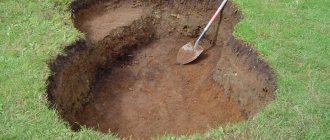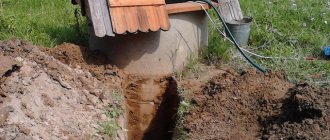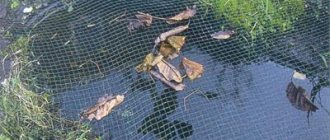Greetings, my dear readers.
Sorry I haven't written for so long. A whole bunch of problems have accumulated, both at home and at work, not only did I sit without the Internet for two weeks - death, melancholy.
Today I will tell you the secret of the ancient diggers and teach you how to dig a hole correctly - in case it comes in handy for someone! It doesn’t matter whether you’re digging or digging, it doesn’t matter what you’re digging for - you’re digging a shambo, a drain hole for waste products, a sewer, you’re digging a hole for a garage or a toilet - the main thing is that you must understand that after reading this article you will become a digging Jedi, only damn, instead of a laser pointer you will have a shovel! So, let's get started my tireless hands!
We made the markings, again I will repeat to you that it doesn’t matter why you are digging, even just for the sake of it. What a romance - he took a shovel and went. As my grandfather said, and his grandfather told him - dig deeper, throw further, rest while you fly!
So, my one-assed, two-bunched creatures - let's look at all the options through the prism of a shovel!
What to consider before starting work
You shouldn’t start work with the primitive attitude of “take more, throw further.” To save yourself from unpleasant surprises and problems in the future, you need to think not about how to quickly dig a trench for a water supply by hand, but about how to do it efficiently and accurately.
To do this, you need to decide on the parameters of the “trench,” find out whether its route intersects with the lines of other communications, decide where to store the excavated soil, mark the most convenient and shortest path from the source to the house, etc.
How to make a trench section
The question of choosing the shape of a trench is far from idle. It depends on its depth, type of soil, groundwater level.
Types of water trenches Source ibb.co
- Rectangular.
This configuration is chosen for dense, non-flowing soil, a small trench width and a depth of no more than 1.5 meters.
- Trapezoidal.
Form for deep excavations over 1.5 meters or more than the height of the digger at the shoulders. Prevents collapse and shedding of loose soil into the ditch.
It is important! First of all, the choice of this form is related to the safety of people performing work in soft soil conditions - sandy or sandy loam. If it collapses, there is a risk of injury and more serious consequences.
- Mixed.
The optimal shape for laying trenches in areas with high groundwater. The soil is removed to the level of their occurrence to form flat inner walls of the ditch, then a narrow rectangular pit is dug to the required depth, which is filled with a drainage mixture of crushed stone or gravel.
What should be the width and depth
Construction codes and regulations strictly regulate only the width of pits with a depth of more than 3 meters. For laying a home water supply, it rarely exceeds the specified value, therefore, when deciding how to quickly dig a trench, the width is chosen arbitrarily, focusing only on the ease of operation and subsequent installation of pipes.
Manual digging of a trench Source ivbb.ru
As a rule, for rectangular recesses it does not exceed 50 cm, and often even equals the width of a shovel. The trapezoidal ditches in the upper part are 70-80 cm wide.
The situation is different with depth - it cannot be chosen arbitrarily, since it is necessary to dig a trench for uninsulated pipes to the level of freezing of the soil plus another 30-50 cm. Otherwise in winter the water in them will freeze, which will lead not only to the cessation of its supply to the house, but and the need to replace the depressurized route. This means repeating all the work, since it is impossible to determine the location of the frozen pipe break without excavation.
The depth of soil freezing depends on the climatic conditions in the region and varies from 30 to 300 cm. You can find out what it is in your area from the architectural department, utility services or local construction organizations. Or use the table of average values by region.
Table of average soil freezing depths for CIS cities Source izchegopostroit.ru
See also: Catalog of companies that specialize in water supply and utility networks
The found value is taken as the initial value and an amendment is made in one direction or another depending on the type of soil.
- Sandy and clayey soil does not freeze so deeply, so before digging a trench for water supply, the calculated depth can be reduced by 30-40 cm.
- Dusty and rocky soil freezes to a great depth, which means that the level of the pipe must be lowered to the same distance from the average mark.
Advice! If the required depth of the trench is very large, it is often more advisable to make it shallower, but insulate the water pipe or lay it with a heating cable.
If the water supply is laid from a centralized pressure source, the depth of the ditch along the entire length may be the same. If the source is an autonomous well or a well with a pump, the route is laid with a slight slope towards it, so that in the event of an accident the water does not remain in the pipes, but flows back by gravity.
Note! Pipes made of low-density polyethylene (HDPE) and polyvinyl chloride (PVC) cannot be laid at a depth of more than 2 meters without a rigid protective casing, since their ring rigidity is low and they can be flattened under the weight of a thick layer of soil.
Scheme of laying a water pipeline with a heating cable from a well Source aquacop.ru
Well bottom maintenance
Every well requires constant maintenance. Regardless of the type of well and the method of arranging its bottom, we strongly recommend cleaning it at least once a year. In practice, we constantly observe the benefits that such a responsible approach provides:
- The well's flow rate remains consistently high throughout its entire operational life.
- The quality of water does not decrease over time, which has a positive effect on the operation of pumping equipment, allows for savings and more rational use of water treatment systems
- There is no heavy silting, so cleaning work takes much less time
- We promptly detect dangerous changes - the occurrence of cracks in aspen panels, rings
If the well is located on quicksand, an aspen shield is installed at the bottom and a reinforced filter is poured, then we recommend monitoring its condition twice a year.
Technology for digging water trenches
When starting work, you need to think not only about how to quickly dig a trench for water supply, but also about how to do it carefully, causing minimal damage to the soil cover and the appearance of the site. This is especially important when the area has already been landscaped, sown with lawn grass or beds have been laid out on it.
In order to restore everything to its previous form upon completion of the work, prepare a place for storing the excavated soil by covering it with film or tarpaulin. If the soil is dense, it can be dumped along the ditch, stepping back from its edge to such a distance that the soil does not fall back.
To preserve the green cover, after marking, carefully remove the turf along the entire line of the future trench and fold it on one side, and the excavated soil on the other. When backfilling it will be easier to restore everything as it was.
A trench dug according to all the rules Source strojdvor.ru
When we use the word “dig”
If we are talking about digging the earth, then we use “o”, that is, “dig.”
It is very easy to check the spelling of this word. You just need to find the test word. And for the word “dig” the test word is “dig”, “excavation”.
The most important example and immediate answer to the question:
- Let's go dig potatoes.
- Digging the ground with a shovel.
There is also an expression: to dig under someone. This expression means to look for some information on another person that could harm him or bring him trouble.
Video description
How a trench is made accurately and quickly using such an earth-moving machine is shown in the video:
It is also possible to cope with such work without the use of equipment, but it will take more time. We suggest considering two methods: traditional, using a shovel, and accelerated, using a drill and a special device.
- Traditional way.
There is nothing complicated about how to properly dig a trench with a shovel. After removing the top turf layer, the soil is loosened with a bayonet shovel and removed with a shovel. It is most convenient to dig the ground in a trench in steps, and not all at once to the entire depth.
Features of wells of different designs
There are two types of structures – shaft and tubular. The first option is much more widespread, because Construction of such a well is usually cheaper and more convenient to use. The shaft structure is universal, and water can be raised using buckets, hand and electric pumps.
Another advantage of the shaft structure over the tubular one is the ease of construction. You can find out how to dig a mine well with your own hands by reading specialized literature and articles.
If desired, everyone can take their advice and dig and arrange a quality water source on their own.
A column, or tube well, is a shallow well, the walls of which are lined with a pipe, and the water is raised using a manual or electric pump
A tube well is built if the aquifer is located shallow, and the owner can use drilling equipment. The advantage of a tubular structure is faster construction. Due to their small diameter, tubular structures are less polluted. They can be built next to residential and commercial buildings.
Both types of wells have their own advantages and disadvantages. When choosing a suitable design, you should take into account all the nuances. Since it is easier to build a mine well without the use of special equipment, in the future we will consider the issues of digging just such a source.
Video description
This video shows how to deepen a narrow trench:
- Fast way.
This method allows you to quickly solve the problem of how to dig a narrow trench. Along the marking line, holes with a diameter of 15 cm are drilled every 3-4 meters with a conventional or motorized drill. If the soil is loose, water is poured into the well during the drilling process.
Drilling wells Source yandex.net
A metal cup of slightly smaller diameter with a partially cut out wall is inserted into the finished hole. The cutout is turned along the channel and the soil is raked into the glass with a narrow hoe. As it is filled, it is removed and emptied.
Purpose of a bottom filter for a well
A bottom filter is a layer-by-layer embankment made of various natural materials that are not washed away by well water. Water passing through the filter is cleaned of debris, harmful impurities and suspended particles present in the well.
The installation of a bottom filter is mandatory in the following cases when:
- it is necessary to protect the bottom of the well from erosion;
- water flows under high pressure;
- at the bottom of the well there is fine or dusty sand;
- the well is opened by quicksand;
- protection of pumping equipment sensitive to clogging is necessary;
- the water level in the well is characterized by large differences, for example, during pump operation or precipitation;
- water quality is unsatisfactory: turbidity, sediment, unpleasant odor. You can read more about the causes of unsatisfactory water quality and how to eliminate them in this material.
Installing a bottom filter is not necessary if the well has exposed hard, fractured clay or rock formation. Do not use bottom protection if the water comes from natural springs. If the dense bottom of the well is not clogged with impurities and suspended particles, additional filtration is not necessary.
In other cases, to obtain high quality water, installing a bottom filter for a well is a mandatory step.
In most cases, wells require a bottom filter to purify the incoming water and improve its taste.
Briefly about the main thing
Before digging a water supply trench, you need to decide on its parameters: profile shape, width and depth.
The section is selected based on the type of soil - it is important that it does not crumble into the channel.
The width is at your discretion and is selected for ease of use, and the depth is correlated with the level of soil freezing.
When marking, it is necessary to take into account the location of other underground communications.
There are several ways to easily dig a trench: using a milling cutter, a regular shovel and a garden or mechanized drill.
Ratings 0
Types of DIY digging tools
To develop soil from a trench, several types of tools are used:
Trench . This tool is equipped with a rectangular bayonet and has a pointed tip. The design helps clear the walls of the trench without polluting the nearby soil. When clearing space for a trench, such a shovel will help remove plant roots that are too deep.- Bayonet. Designed for digging up soil. They are also convenient for digging trenches, since the bayonet has a slightly pointed end. They come in rectangular or square shape. If the bayonet is flat and square, it is convenient for them to dig out tightly compacted soil. If the bayonet is curved, it is perfect for digging out the earth from a trench.
- Drainage (narrow) . A drainage shovel is also called narrow because of the special width of its scoop. It is not only narrow, but long and is just suitable for creating holes and trenches. A drainage shovel with a curved scoop can easily remove soil from a dug trench. The tool is equipped with a special platform for the foot - it allows you to save your shoes and prevent pain that can occur when using a regular shovel.
- Sovkovaya. Necessary for transporting bulk material. For example, you can dig up soil with a bayonet or drainage shovel, and with a shovel you can collect it and bring it to the surface. This tool has wide and flat bayonets at the edges.
- Scraper. Used additionally to remove debris. They are also mounted on a long handle and will help quickly remove excess dirt from the trench.
- In the shape of a crescent. They are used to cut small turf and remove the fertile layer, you can use a small crescent-shaped spatula.
Recommendations for making a cylinder
The easiest way is to make a gate for a well from a log. You don't need any drawings for this. When doing the work yourself, you should adhere to the following recommendations:
- The length of the log should be 100-150 mm less than the distance between the supports along the edges of the well.
- To make a high-quality gate for a well, the log must be sanded and treated with protective impregnations. They will protect the wood from rotting.
- The edges of the cylindrical part are fastened with a metal ring (clamp). This will protect the wood from cracking and at the same time allow you to remove the cylinder easily and effortlessly.
- Metal discs with hubs are fixed to the end parts of the log. You can attach rods to rotate the gate in them. This is done using suitable fasteners. To do this, holes are drilled in the disks for fasteners. Another option involves welding the axle shafts to steel disks.
- In some cases, when making it yourself, it will be easier to simply hammer the ends of the axle shafts from a rod or thin pipe into the ends of a wooden gate. At the same time, to facilitate driving, the ends of the pipe are flattened, and the rods are sharpened; holes are also pre-drilled in the ends of the logs of a smaller diameter than steel products. This fixation will prevent the rods from turning in the log when the handle is rotated.
- To make it more convenient to regulate the gate’s displacement relative to the axis, bushings are installed in the gaps between the support drains and the cylinder on each side.
When to use the word "drip"
The word “drip” is written when talking about water dripping from a tap or other liquid.
Examples:
- Water drips from the tap.
- Rain is dripping outside the window.
- Icicles will drip.
There is also an expression: drip on your brains. It means to lecture, to annoy. That’s why they often say “stop fooling around with your brains.”











